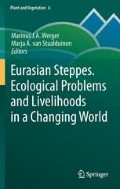Abstract
In Spain, the extensive, largely treeless areas in semi-arid environments are considered as steppes, dominated by small shrubs, with forbs and grasses (dwarf shrub steppes). The main factor for their occurrence seems to be climatic continentality and drought.
The Iberian steppe vegetation contains plant species of South Mediterranean Irano-Turanian and of Mediterranean Saharo-Sindian affinities. The Mediterranean-Irano-Turanian element consists of eastern steppe species that spread through the Mediterranean basin, with many vicariances at generic level. The Mediterranean-Saharo-Sindian element of the Iberian steppes consists of plants derived from the Tertiary subtropical flora of the open African spaces. Plant endemism reaches 42% in the Iberian steppes.
The steppes harbour steppe bird communities with highly endangered species. Steppe birds in general depend very much on the structure of the vegetation. Many bird species are seriously at risk, while processes, like agricultural intensification, abandonment of grazing, changes of land use, and construction activities, cause degeneration and destruction of many steppe areas.
Access this chapter
Tax calculation will be finalised at checkout
Purchases are for personal use only
References
Bauer Manderscheid E (1980) Los montes de España en la historia. Ministerio de Agricultura, Madrid, p 610
Bota G, Morales MB, Mañosa S, Camprodon J (eds) (2005) Ecology and conservation of steppe-land birds. Lynx Edicions & Centre Tecnològic Forestal de Catalunya, Barcelona
Braun-Blanquet J, de Bolos O (1987) Las comunidades vegetales de la depresión del Ebro y su dinamismo. Deleg. Medio Ambiente, Ayto. de Zaragoza, Spain
Costa M, Morla C, Sainz OH (eds) (1997) Los bosques ibéricos. Planeta, Barcelona
Dantín Cereceda J (1916) Dry-Farming ibérico. Cultivo de las tierras de secano en las comarcas áridas de España. Imprenta Gutemberg, Guadalajara
De Juana E, Santos T, Súarez F, Tellería JL (1988) Status and conservation of steppe birds and their habitats in Spain. In: Goriup PD (ed) Ecology and conservation of grassland birds. ICBP technical publication no 7, Cambridge, pp 113–123
Fidalgo Hijano C (1987) La transformación humana del paisaje en la serranía de Atienza. Ediciones de la Universidad Autónoma de Madrid, Madrid, 116 pp
García Antón M, Maldonado J, Morla C, Sainz Ollero H (2002) Fitogeografía histórica de la península Ibérica. In: Pineda FD, de Miguel JM, Casado MA, Montalvo JM (eds) La Diversidad Biológica de España. Pearson educación S.A, Madrid, pp 45–64
Gómez Campo C (1981) Taxonomic and evolutionary relationships in the genus Vella. Bot J Linn Soc 82(2):165–179
González-Sampériz P (2004) Evolución paleoambiental del sector central de la Cuenca del Ebro durante el Pleistoceno Superior y Holoceno. Inst. Pirenaico de Ecología – CSIC. Dpto de Ciencias de la Antigüedad. Univ. de Zaragoza
Jäger EJ (1971) Die pflanzengeographische Stellung der «Steppen» der Iberian Halbinsel. Flora 160:217–256
Mota JF, Sánchez Gómez P, Merlo ME, Catalán P, Laguna E, de la Cruz M, Navarro FB, Marchal F, Bartolomé C, Martínez Labarga JM, Sainz Ollero H, Francisco Valle F, Serra L, Martínez Hernández F, Garrido JA, Pérez García FJ (2009) Aproximación a la checklist de los gipsófitos ibéricos. Anal Biol 31:71–80
Quézel P (1978) Analysis of the flora of Mediterranean and Saharan Africa. Ann Miss Bot Gard 65:479–534
Reyes Prósper E (1915) Las estepas de España y su vegetación. Publicación a costa de la Casa Real, Madrid
Sainz Ollero H (2003) Introducción al paisaje vegetal español. In: Martí R, del Moral J (eds) Atlas de las Aves reproductoras de España. Dirección General de Conservación de la Naturaleza-Sociedad Española de Ornitologia, Madrid, pp 49–53
Sainz Ollero H, Domínguez Lozano F (2011) El contexto geobotánico. In: Domínguez Lozano F, Guzmán Otano D, Moreno Saiz JC (eds) Biología de la Conservación de Vella pseudocytisus subespecie paui, una planta amenazada en Aragón. Consejo de Protección de la Naturaleza de Aragón, Serie Investigación, Zaragoza
Sainz Ollero H, Sánchez de Dios R, García-Cervigón Morales A (2010) La cartografía sintética de los paisajes vegetales españoles: una asignatura pendiente en geobotánica. Ecología 23:249–272
Shepherd G (2004) The ecosystem approach: five steps to implementation. IUCN, Gland/Cambridge
Suárez F, Sainz Ollero H, Santos T, González Bernáldez F (1992) Las estepas ibéricas. Unidades temáticas ambientales, MOPT, Madrid
Walter H (1977) Zonas de vegetación y clima. 1ª reimpr. 1994, Omega, Madrid
Walter H (1984) Vegetation of the Earth. Springer, Berlin
Willkomm M (1852) Die Strand-und Steppengebeite der Iberischen Halbinsel und deren Vegetation W. Engelmann Leipzig
Willkomm M (1896) Grundzüge der Pflanzenverbreitung auf der Iberischen Halbinsel und deren Vegetation. In: Engler EA, Drude O (eds) Die Vegetation der Erde (I). W. Engelmann, Leipzig (reimp. 1976. A R Gantner Verlag K.G.FL. 9490. Vaduz)
WWF-España (2009) Hernández L, Romero F coord. Bosques españoles. Los bosques que nos quedan y propuestas de WWF para su restauración. Madrid (Dep. Legal: M-40080-2009)
Author information
Authors and Affiliations
Corresponding author
Editor information
Editors and Affiliations
Rights and permissions
Copyright information
© 2012 Springer Science+Business Media B.V.
About this chapter
Cite this chapter
Ollero, H.S., van Staalduinen, M.A. (2012). Iberian Steppes. In: Werger, M., van Staalduinen, M. (eds) Eurasian Steppes. Ecological Problems and Livelihoods in a Changing World. Plant and Vegetation, vol 6. Springer, Dordrecht. https://doi.org/10.1007/978-94-007-3886-7_9
Download citation
DOI: https://doi.org/10.1007/978-94-007-3886-7_9
Published:
Publisher Name: Springer, Dordrecht
Print ISBN: 978-94-007-3885-0
Online ISBN: 978-94-007-3886-7
eBook Packages: Biomedical and Life SciencesBiomedical and Life Sciences (R0)

